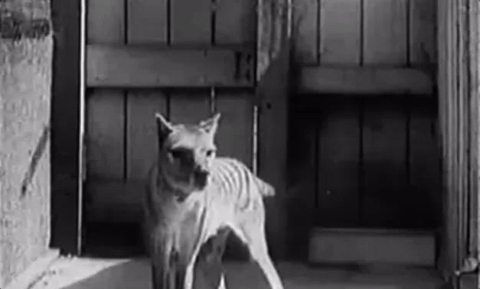- The Tasmanian tiger, or thylacine, most likely went extinct in the late 1990s or early 2000s, and could still persist in the most remote parts of the island, according to new research that is still undergoing peer review.
- More than 1,200 records of sightings and physical evidence from 1910 up to 2019 were collected and collated by scientists at the University of Tasmania and used to model where and when the thylacine is likely to have persisted.
- This study challenges the accepted consensus that the thylacine went extinct in the decade or two after the last known individual died in Hobart Zoo in 1936.
- The authors say they believe their novel method for using citizen science could be applied to help find other species either believed to be extinct or known to be extremely rare.
In July 2019, Australian authorities on the island of Tasmania received a report of a footprint spotted by an unnamed individual on a walk up to Sleeping Beauty Mountain in the southeast of the state.

“Wasn’t able to take a photo, however he googled it when he got home and believes it was a Tasmanian Tiger,” the report reads, according to the Tasmanian Department of Primary Industries, Parks, Water and Environment (DPIPWE).
That same year, a government plant biologist saw what they believed to be a Tasmanian tiger (Thylacinus cynocephalus), or thylacine, from 30 meters (100 feet) away in a remote area.
“Good description given, bounded into bush,” the report states.
In 2018, three cyclists said they witnessed a thylacine crossing the road in front of them.

These are just three of more than 1,200 alleged thylacine sightings reported between 1910 and 2019 in Tasmania that have been collated and analyzed by Barry Brook, a mammal ecologist at the University of Tasmania, and colleagues to create the Tasmanian Thylacine Sighting Records Database, which they used to estimate an extinction date for the thylacine.
Their findings, released in pre-print format in January through bioRxiv and undergoing peer review, indicate the iconic Australian marsupial predator most likely died out in the late 1990s or early 2000s — decades later than has been assumed.
The results surprised even Brook.
“Contrary to expectations, the inferred extinction window is wide and relatively recent, spanning from the 1980s to the present day, with extinction most likely in the late 1990s or early 2000s,” the paper says. “While improbable, these aggregate data and modeling suggest some chance of ongoing persistence in the remote wilderness of the island.”
“Contrary to expectations” is arguably an understatement. The thylacine was declared extinct by the IUCN in 1982. Officially, the last-known living thylacine died in 1936 in Hobart Zoo.

But as the database compiled by Brook and his team shows, evidence for its continued survival emerges every year. Most of these reports are likely to be cases of mistaken identity or outright fabrications, but Brook took this into account in his modeling. He and his team assessed each reported sighting according to its likely veracity and then used these probabilities to estimate when the thylacine is most likely to have died out. The Sleeping Beauty sighting, for instance, was rated a 2 (out of a possible 5), meaning it was given little chance of being true. The other two both received a 4: the first because it was made by a scientist, the second because more than one person was involved, both factors that reduce the possibility the reports were outright lies or that the observers mistook another species for a thylacine.
“The records of an average Joe who might have seen one are given about a 1% probability of being correct,” Brook told Mongabay in a Zoom interview, “whereas someone like a park ranger, or in the earlier days, bushmen and trappers, would both have had a much better chance of getting it right and were given about a 25 or 50% probability of being right.”
Brook’s data suggest that if thylacines do survive — or did until 20 years or so ago — then they are, or were, most likely holding out in the western and southwestern portions of the island. Areas such as Franklin-Gordon Wild Rivers National Park and the broader Wilderness World Heritage Area are extremely inaccessible, and Brook says it is plausible a few individuals could be there without being detected.
And though this region wouldn’t be optimal habitat for thylacines, it’s clear that pademelons (small, chunky kangaroo-like marsupials of the genus Thylogale) and wallabies, known from old accounts to be their favored prey, live there in sufficient numbers to support populations in reduced densities.


Other studies looking at the likely survival of the thylacine have come up with very different results. In 2017, Colin Carlson, an ecologist with an interest in modeling the extinction risk for species, published a paper in Conservation Biology that placed the likelihood of the thylacine still surviving at 1 in 1.6 trillion. The likely extinction date was sometime between 1936 and 1943, he wrote, “with the most optimistic scenario” suggesting it did not persist beyond the 1960s.
“The search for the thylacine, much like similar efforts to ‘rediscover’ the ivory-billed woodpecker and other recently extinct charismatic species, is likely to be fruitless,” Carlson and his co-authors wrote.
But specialists in Australian wildlife contacted by Mongabay said Brook’s paper was a worthwhile contribution to thylacine science. Bill Laurance, of James Cook University in Queensland and who led an expedition to Cape York, the northernmost tip of the Australian continent, to search for the thylacine and other mammals in 2017, said the question of when (or if) the thylacine went extinct depends on data of uncertain quality. Editor’s note: Bill Laurance is a member of Mongabay’s advisory board.
“At least what Barry has done is to take a shot at trying to quantify the probability [the data are correct] and that sounds like an eminently sensible thing to do,” he said.
Laurance pointed out that a number of supposedly extinct species have subsequently been “rediscovered,” including the coelacanth, the Wollemi pine, the mountain pygmy possum and the solenodon. “I think it’s really important to maintain that frame of mind where you expect some surprises, you try to be rigorous when you go about your science and be upfront about your uncertainties,” Laurance told Mongabay via Zoom.
Jack Ashby, assistant director of the Museum of Zoology at the University of Cambridge in the U.K. and an expert on Australian mammals, described the Tasmanian Thylacine Sighting Records Database as an extraordinary resource.
“They have put together every possible sighting that has been recorded and gone far beyond what the government maintains,” he said. “It is fantastically exciting for the future of thylacine science.”
![These maps show the estimated year of extirpation for the thylacine across Tasmania based on the sightings records collected by Brook and colleagues. The first pair (Maps A and B) are for the records between 1910 and 1937 – when the last physical evidence of thylacines was recorded – and therefore contain a mix of certain and uncertain data. The second pair contain only uncertain data – i.e., only sightings that cannot be proved. “The congruence between [the two sets of maps] is large, and that’s not something that was forced upon them," Brook said. "If it was just random people making random reports, I don’t think you would have expected to see such strong congruence between these maps. I think that signals that second map is telling us something real, rather than being just all lies or all mistakes.”](https://imgs.mongabay.com/wp-content/uploads/sites/20/2021/02/04202459/0203-brooks-fig-small.jpg)
Others are less sure about whether the use of these sightings records is appropriate. Nick Mooney, a former wildlife manager at DPIPWE and a well-known conservationist and writer, said in a telephone interview that in his experience, people were very likely to see a Tasmanian species, such as a wallaby, and imagine what they believed to be a thylacine. Observers also commonly greatly underestimated the distance at which they saw the creature.
Mooney investigated the most well-known and arguably most credible thylacine sighting in the past half century. On a rainy night in 1982, park ranger Hans Naarding was sleeping in his vehicle when he woke up to find one right in front of him. He was unable to take a photograph, but reported watching it for three minutes.
Because Naarding was a wildlife expert, the consensus is he could not have been mistaken. It was either genuine, an outright fabrication or very possibly — though this is somewhat countered by the length of time Naarding said the encounter lasted — an illusion or waking dream. As a result, it’s very hard to reach any conclusion about its accuracy, Mooney said. He has, however, heard one account, dating back to 1973, from a friend that he does believe.
In fact, Brook hasn’t even included all the sightings of recent years, according to Warren Darragh of the Thylacine Research Unit (TRU). Some of the sightings they hear about are put on their website, but the best ones “we keep under our hat,” Darragh said.
“I would reckon there are half a dozen high quality sightings not included in the Brook paper,” he added, including three from 2020. Despite these reports, Darragh and his two colleagues within the TRU start from the premise that the thylacine is “probably extinct.”

Brook said his paper showed the value of “assembling, curating and maintaining a database of not just scientific records, but sightings by the public.” Scientific records, including visual evidence such as camera-trap data, have the advantage of being more likely to be correct, but they can never match the quantity supplied by lay observers and witnesses.
“It emphasizes that if you can gather and encourage best use of citizen science data, then that’s helpful for a species on the brink of extinction,” Brook said. “We want people to think that if you report a sighting, you are not going to be laughed at, you’re not going to be believed or disbelieved, it will be taken into account in a rigorous and fair way and I think that’s a good message to communicate to people.”
Brook also rejects criticism that the hunt for the thylacine diverts resources and attention away from animals more deserving of conservation action. Charismatic species can help to attract funding for work that would not otherwise have happened, he said.
Brook gives the thylacine about a one-in-10 probability of still surviving. With camera traps increasingly used by scientists (Brook uses a fleet of 500 to monitor how mammal populations respond to land-use changes and climate change) and groups such as the Thylacine Research Unit (TRU), he says it’s almost now or never for this species.
“If [it] hasn’t been seen or photographed in the next decade, then we can really close the book on the thylacine,” Brook said. “Never before have we had such an excellent opportunity to detect it.”
Citations:
Brook, B. W., Sleightholme, S. R., Campbell, C. R., Jarić, I., & Buettel, J. C. (2021). Extinction of the thylacine. bioRxiv. doi:10.1101/2021.01.18.427214
Carlson, C. J., Bond, A. L., & Burgio, K. R. (2018). Estimating the extinction date of the thylacine with mixed certainty data. Conservation Biology, 32(2), 477-483. doi:10.1111/cobi.13037
Feedback: Use this form to send a message to the editor of this post. If you want to post a public comment, you can do that at the bottom of the page.
